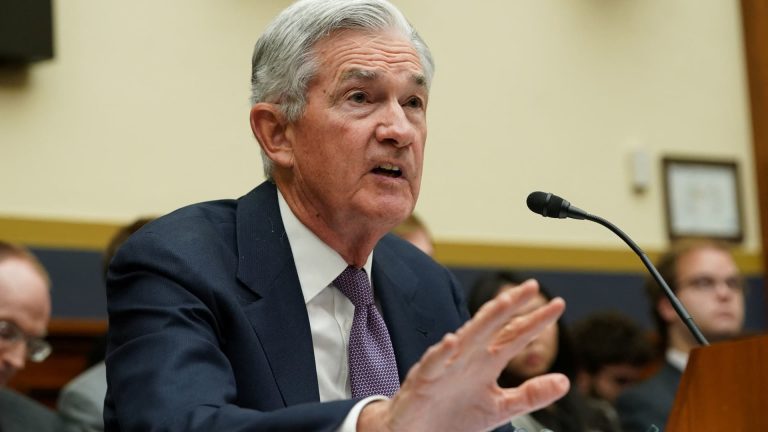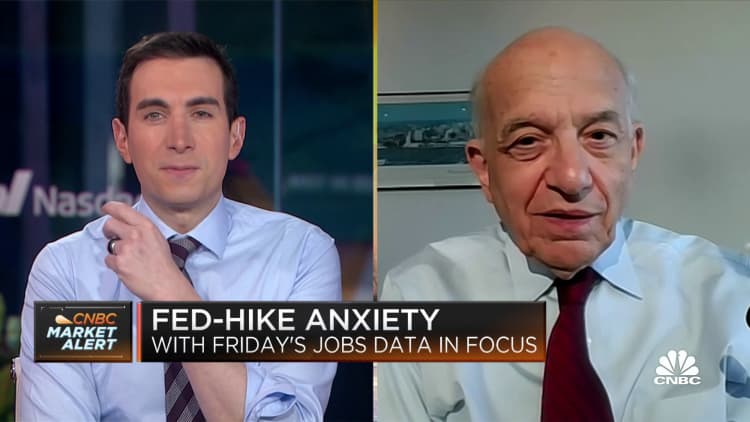
[ad_1]
Federal Reserve Chair Jerome H. Powell testifies before a House Financial Services hearing on “The Federal Reserve’s Semi-Annual Monetary Policy Report” on Capitol Hill in Washington, U.S., March 8, 2023.
Kevin Lamarque | Reuters
Federal Reserve Chairman Jerome Powell’s prepared speech this week to Congress took just a few minutes, but it changed everything.
In those remarks, the central bank leader set out a new paradigm for how the Fed views its policy path, one that apparently will see even higher interest rates for a longer period of time than previously thought.
The aftermath has forced the market, which long had been looking for the Fed to blink in its inflation fight, to recalibrate its own views to coincide more with policymakers who have been warning about a higher-for-longer approach to interest rates.
“We have clearly had a choreographed chorus of Fed speakers for two weeks that was getting us to that place,” said Art Hogan, chief market strategist at B. Riley Wealth Management. “It took Jay Powell, over the course of a very brief prepared statement and a Q&A, to get those expectations cemented into a higher place.”
As part of his mandated semiannual testimony on monetary policy, Powell spoke Tuesday before the Senate Banking Committee then the day after to the House Financial Services Committee.

Heading into the appearances, markets had been looking for the Fed to raise its benchmark interest rate by 0.25 percentage point at its meeting later this month, then perhaps two more moves before stopping, with the end point around 5.25%.
That changed after Powell’s appearance, during which he cautioned that if inflation data remains strong, he expects rates to go “higher than previously anticipated” and possibly at a faster pace than a quarter point at a time.
Markets now strongly expect a half-point increase in March and the peak, or terminal rate, to hit close to 5.75% before the Fed is finished.
When the facts change
So what changed?
Basically, it was the January inflation data plus signs that the labor market remains remarkably strong despite the Fed’s efforts to slow it down. That made Powell, who only weeks earlier had talked about “disinflationary” forces at play, switch gears and start talking tough again on monetary policy.
“He’s adjusting to data coming in, which the entire board should be doing,” Hogan said. “If the facts change again through the February and March data, he’ll likely become flexible on that side and not push this too far to the point where they need to break something.”
Indeed, Powell said he’ll be watching a pivotal array of upcoming data closely — Friday’s nonfarm payrolls report, followed by next week’s look at the consumer and producer price indexes.
Goldman Sachs economists are holding to their forecast for a quarter-point hike at the March 21-22 Federal Open Market Committee meeting, but concede that it’s a “close call” between that and a half point.
Should the Fed have to tilt in the more aggressive direction, Goldman warned in a client note that it could have market impacts, with stocks selling off “more sharply” and downward pressure on commodities, plus upward pressure on the dollar.
Worries over consequences
Powell faced some questioning this week over the Fed’s inflation-fighting strategies.
Some more progressive legislators such as Sen. Elizabeth Warren, D-Mass., and Rep. Ayanna Pressley, D-Mass., charged that the rate hikes will result in 2 million layoffs and hurt working-class families disproportionately. Powell countered that inflation also is hammering those at the bottom end of the income spectrum.
“This is what he is supposed to do,” Joseph Brusuelas, chief economist at advisory firm RSM, said of Powell’s evolving policy stances. “Jay Powell is a punching bag in Washington at this point. He’s going to take the blame for establishing price stability. If he does that well, in the years to come he’ll be venerated. People will speak very highly of him.”
Brusuelas is among those who think the Fed should accelerate its inflation battle with a half-point rate hike.
However, he said policymakers could be swayed by a potentially softer jobs report and inflation data next week that reverses course and shows price increases abating. Economists expect that payrolls grew by 225,000 in February, according to Dow Jones, and there’s widespread belief that January’s 517,000 surge will be revised down in this report, perhaps significantly.

“The economy is just too resilient at this point,” Brusuelas said. “They need to generate sufficient labor slack to cool off the economy.”
Slack was not evident in this week’s Labor Department report of job openings in January, which outnumbered available workers by a 1.9 to 1 margin.
Data like that could push the Fed into even further tightening, according to economists at Nomura. The firm said future actions could include adjustments to the Fed’s program to slash its bond portfolio, with one option being to remove the $95 billion monthly reduction cap currently in place.
For the moment, markets are continuing to price in higher rates.
Though Powell made a special point Wednesday to emphasize that no decision has been made yet on the March rate move, markets essentially ignored him. Traders in the futures market were pricing in a terminal rate of 5.625% later this year, well above where it was before Powell spoke.
[ad_2]
Source link